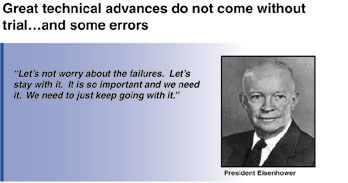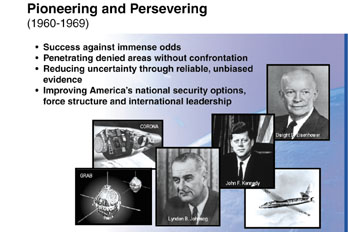Americans have found themselves captivated by adventure novels
like Tom Clancy's "Patriot Games" that come to life
on the big screen. The scenes depicting the use of U.S. spy satellites
add to the intrigue. We are mesmerized as a spy satellite transmits
what appears to be real-time video of a night assault by U.S.
Special Operations Forces on a terrorist camp located in the Sahara
Desert. The satellite images vividly depict the assault force
in action and terrorists dropping to the ground from close-range
gunfire. They convey a sense of CNN-like coverage of breaking
news.
The capabilities of these "movie satellites" (not constrained
by the laws of physics) are the result of computer-simulated graphics
and skillful special effects. Nonetheless, the premise for such
capabilities is the spectacular technological achievements in
satellite reconnaissance pioneered by the National Reconnaissance
Office (NRO).
The NRO emerged at the height of the Cold War. During that time
in U.S. history, the nation faced the threat of destruction from
a nuclear attack. The Soviet Union's nuclear weapons and closed
Communist society were the dominant threat to U.S. national security.
Weekly civil defense drills and backyard bomb shelters instilled
a real sense of "clear and present danger" to the American
public.
The lack of insight into the Soviet Union during the early days
of the Cold War and the fear of its nuclear arsenal were the focus
of national attention. Tensions between the United States and
the Soviet Union were high. Ambiguous and conflicting information
from traditional intelligence sources concerning the extent of
Soviet nuclear capabilities threatened to fuel the nuclear arms
race. The risk of nuclear war led the U.S. Air Force to consider
building as many as 10,000 ICBMs to counter the perceived threat.
The Strategic Air Command flew around-the-clock airborne alert
missions with B-52 bombers armed with nuclear warheads in order
to deter the USSR from launching a preemptive nuclear strike on
the United States.
In an effort to gain timely and more accurate information concerning
Soviet capabilities, President Eisenhower initiated a covert program
to develop an overhead reconnaissance capability to gather intelligence
on the development, capabilities, location, and readiness of Soviet
strategic nuclear forces. Advanced technology elements of the
CIA and the Air Force were joined together to attack this problem.
They rapidly developed the U-2 reconnaissance aircraft, which
was able to penetrate Soviet airspace at higher altitudes than
those at which Soviet fighters could then operate.

However, in their four years of operation, the U-2s were able
to cover only one-tenth of the 10 million square miles of the
USSR and provide only limited insight into Soviet strategic nuclear
capabilities. Further, these flights were ended on May 1, 1960
after a U-2 piloted by Francis Gary Powers was shot down by a
Soviet surface-to-air missile. Powers was captured and the Soviets
turned the incident into a major propaganda event. As a result,
the need for a satellite reconnaissance capability to provide
assured access over denied Soviet territory became paramount to
U.S. national security.
The Air Force and CIA had been working on covert reconnaissance
capabilities from space for some time. This was a high-risk effort
and the program suffered a dozen failed missions before achieving
its first success in August 1960.
The then-covert program, named Corona, finally yielded results
that were considered spectacular at the time. The amount of Soviet
territory covered in the film recovered from the very first Corona
mission, for example, exceeded the area that had been covered
previously by all the U-2 flights.
The information collected by Corona provided U.S. military planners
and policy-makers with concrete evidence that the Soviet Union
did not have overwhelming strategic superiority as had been feared.
Subsequently, knowledge of the size and characteristics of Soviet
nuclear forces made verification of arms control treaties possible
and enabled the firm U.S. response to Soviet military expansion
in the 1980s that eventually induced the USSR to collapse.
Like the Air Force in its efforts to collect imagery, the Navy
and Air Force had tried to gather electronic radar signals intelligence
(ELINT) by conducting aircraft flights along the periphery of
the USSR, but these efforts could never provide more than a fraction
of the required intelligence. As a result, the Navy in 1958 proposed
an ELINT satellite. The proposal was supported by the Department
of Defense and CIA, and was approved by President Eisenhower in
1959. The Naval Research Laboratory developed the satellite under
the cover of an experimental solar radiation research satellite
called GRAB (Galactic Radiation and Background). The first launch
in June 1960 succeeded in orbiting a GRAB satellite. Like Corona,
however, many early GRAB missions were unsuccessful and four of
the next five missions failed. The program nevertheless continued.

The data provided by the successful GRAB missions were priceless.
The ELINT was used to develop operational plans for retaliatory
strikes against the Soviet Union in the event of war. The National
Security Agency analyzed and catalogued the data, determining
from it, for example, that the Soviets were operating a radar
in support of an anti-ballistic missile capability as early as
the early 1960s. Navy programs were incorporated into NRO in 1962.
GRAB was succeeded by other NRO satellite collectors of signals
intelligence that have operated ever since.
A more recent example of the NRO's contribution to U.S. national
security is the electro-optical imagery satellite program. The
Corona photographic satellite system had limitations. The duration
of missions was limited by the amount of film that could be carried
on board, and the images obtained were not available to users
for days or weeks after they were taken since all film had to
be expended and the film capsule recovered before it could be
processed.

NRO engineers addressed these challenges. They were able to develop
an electronic "eye" that was able to convert light waves
into electrical signals that could be relayed to Earth in near-real
time. This and other technologies necessary electro-optical satellite
system developed by the NRO have found their way into commercial
and individual uses, including commercial electro-optical imagery
satellites.
The NRO's real-time imagery satellite program was a lengthy effort.
It was costly and often the subject of intense budgetary debate.
Fortunately, influential individuals like Deputy Secretary of
Defense David Packard, a founder of the Hewlett-Packard Corporation
and an electrical engineer, were able to understand the program's
technical feasibility and value and lent it their full support.
The first electro-optical satellite reconnaissance system--the
name of which is still classified--was deployed by the NRO in
1976. The electro-optical imagery satellite system was declared
operational by President Jimmy Carter on his first day in office,
January 20, 1977.
Those satellites, and their improved successors, have enabled
the United States to base its national security strategy on facts
rather than fear and on empirical evidence rather than speculation.
As President Lyndon B. Johnson said, commenting in March 1967
on the value of the NRO's photo-reconnaissance satellites:



